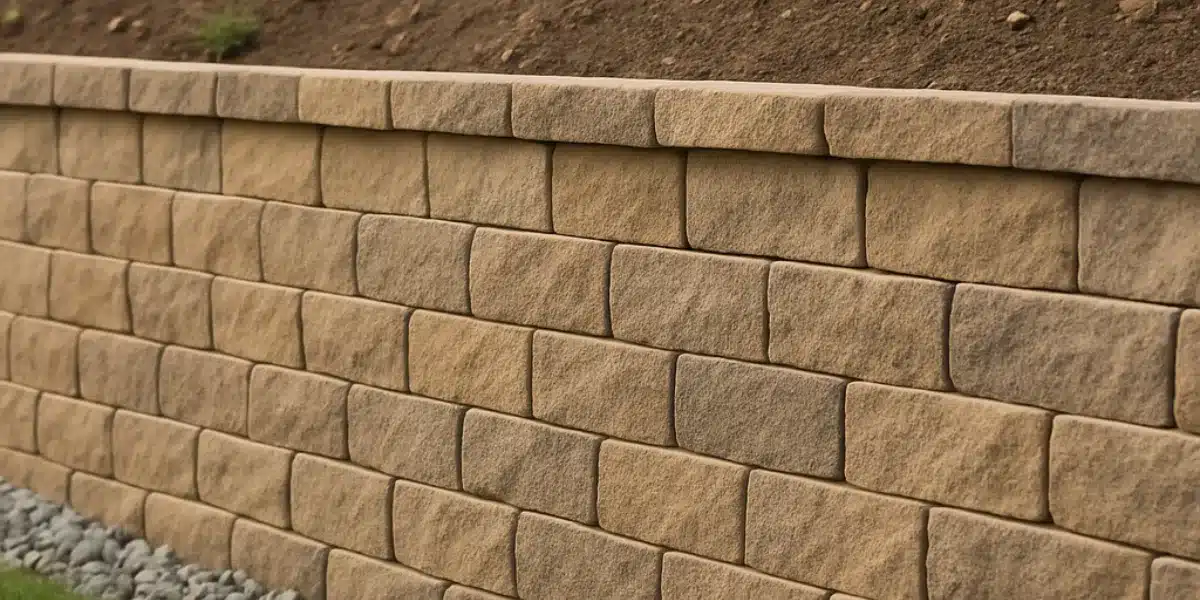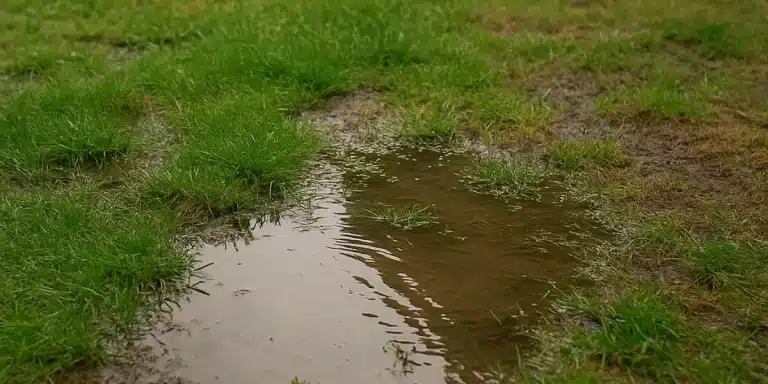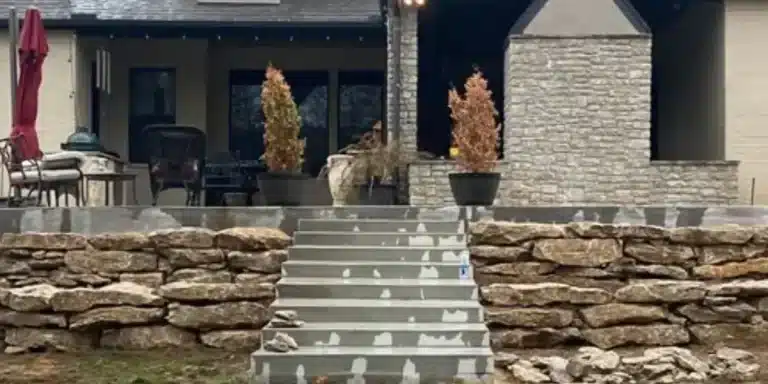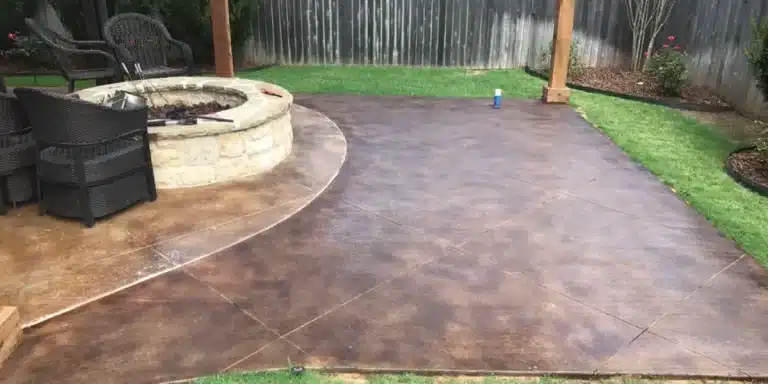How to Fix Drainage Behind Your Retaining Wall
Retaining walls are built to hold back soil, prevent erosion, and enhance your landscape. But without proper drainage, even a well-built wall can fail over time. If you're seeing bulging, cracks, or water seepage behind your wall, poor drainage is likely the cause.
This guide explains why drainage matters, how to identify problems, and how Perfection Outdoor Solutions can fix them—protecting both your property and your investment.
Why drainage is critical behind retaining walls
Water might seem harmless, but when it’s trapped behind a retaining wall, it becomes a powerful and destructive force. Every time it rains or irrigation water flows across your landscape, that moisture needs a safe path to drain away. Without a proper drainage system, water accumulates behind the wall—gradually increasing lateral pressure against the structure.
This pressure builds silently but steadily, eventually pushing the wall out of alignment or weakening its foundation. Even the strongest wall materials—block, stone, timber—can’t hold up indefinitely when water has nowhere to go.
Some of the most common (and costly) consequences include:
-
- Bowing or leaning walls as pressure from saturated soil forces them outward
- Cracks or separation in wall blocks, which compromise structural integrity
- Soil erosion and sinkholes behind or below the wall due to water washout
- Surface mold, mildew, and efflorescence, which indicate trapped moisture
- Premature failure of the entire wall, requiring full replacement
Proper drainage doesn’t just extend the life of your retaining wall—it protects your entire landscape. It safeguards nearby structures like patios, driveways, or foundations, prevents landscape erosion, and reduces maintenance costs in the long run.
At Perfection Outdoor Solutions, we design and repair retaining walls with smart drainage strategies built in—ensuring your investment stays strong through every season.
Signs your wall has drainage issues
Retaining wall problems don’t always appear overnight—but early signs of drainage failure are often easy to spot if you know what to look for. Catching these issues early can save you from major structural damage and costly repairs down the line.
Here are the most common warning signs that your retaining wall isn’t draining properly:
-
- Standing water or soggy soil near the wall
After a rainstorm or sprinkler cycle, water should not pool behind or at the base of the wall. If it does, it’s a strong indicator that drainage is blocked or nonexistent. - Bulging, bowing, or leaning wall sections
These structural shifts occur when water pressure behind the wall becomes too great. Even a slight lean can indicate a growing problem that needs immediate attention. - Cracks in the wall material
Look for horizontal or stair-step cracks in blocks, stone, or mortar joints. These may point to long-term pressure buildup from trapped moisture, especially in older or improperly built walls. - Erosion or sinkholes around the wall
Soil that’s washing away from behind or under the wall can destabilize the structure. You might also notice exposed roots, washed-out mulch, or sudden dips in nearby ground. - Discoloration, staining, or mildew on the wall face
Water stains or mold growth on the visible surface are often signs that water is seeping through from behind, indicating poor drainage and prolonged moisture exposure.
- Standing water or soggy soil near the wall
If you’ve spotted one or more of these signs—especially if they’ve worsened over time—it’s crucial to act quickly. Drainage issues behind retaining walls don’t resolve on their own. Left unchecked, they can lead to total wall failure or damage to nearby landscaping and foundations.
Perfection Outdoor Solutions can inspect the wall, identify the root cause, and recommend effective drainage solutions tailored to your Tulsa-area property.
Common causes of poor drainage
Retaining walls are only as strong as the drainage system behind them. When water can’t escape properly, it builds up and puts pressure on the wall structure. Understanding the most common reasons for drainage failure can help you spot issues early and plan for effective repairs.
Here are some of the top culprits behind drainage problems in retaining walls:
-
- No drainage pipe or outlet at the wall base
A French drain or perforated pipe installed behind the wall is critical for directing water away. If this pipe is missing, improperly sloped, or lacks an outlet, water will collect behind the wall instead of being carried offsite. - Improper backfill material
The space behind a retaining wall should be filled with clean gravel or crushed stone—not clay or soil that holds water. Using compacted native clay soil, which is common in the Tulsa area, traps moisture and prevents drainage. - Missing or blocked weep holes
Weep holes are small openings at the base of some retaining walls that allow water to escape. Without them, or if they become clogged with dirt or debris, water stays trapped behind the wall. - Clogged or damaged drainage pipes
Even if your wall was built with proper drainage in place, pipes can become blocked with silt, roots, or sediment over time. Cracked or crushed pipes may leak water into the surrounding soil, causing soft spots and erosion. - Poor surface grading
The slope of the ground above the retaining wall should direct water away from the structure—not toward it. If nearby areas funnel rainwater toward the wall, drainage components can quickly become overwhelmed. - Over-irrigation or sprinkler misalignment
Excessive watering or sprinklers pointed toward the wall can mimic the effects of heavy rain, especially in poorly draining soil. This leads to constant moisture buildup, even in dry seasons.
- No drainage pipe or outlet at the wall base
In the Tulsa area and surrounding communities, our dense clay-heavy soils make these issues even more problematic. Without proper drainage design and materials, even well-built walls can fail prematurely. That’s why Perfection Outdoor Solutions always accounts for local soil conditions when designing or repairing retaining wall drainage systems.
How we fix drainage behind retaining walls
At Perfection Outdoor Solutions, we take a comprehensive, long-term approach to correcting retaining wall drainage issues. We don’t just patch the problem—we identify the root cause and implement permanent solutions.
Our typical process includes:
-
- Site inspection and assessment
We examine the structure, soil type, and surrounding drainage patterns. - Installing or repairing a perforated drain pipe
Often called a French drain, this pipe runs along the base of the wall to collect and redirect water. - Backfilling with washed gravel and drainage fabric
This allows water to flow freely while filtering out debris that could clog pipes. - Adding weep holes
In stone or block walls, weep holes relieve pressure by allowing water to escape through the front of the wall. - Redirecting surface water
We regrade the surrounding area or install swales to channel water away from the wall and your foundation. - Optional additions
For more complex drainage issues, we may incorporate dry creek beds, catch basins, or sump systems.
- Site inspection and assessment
Each fix is tailored to your property, wall construction, and soil conditions.
Preventing future issues
Fixing a drainage problem behind a retaining wall is important—but preventing it from happening again is even more critical. With regular maintenance and thoughtful planning, you can avoid costly damage and extend the life of your wall and landscape.
Here are some best practices to protect your retaining wall from water-related damage:
-
- Schedule annual inspections
Over time, settling soil, shifting materials, and weather events can all affect your wall’s performance. Annual inspections help catch minor issues—such as early cracking or soil movement—before they become expensive repairs. - Keep weep holes and drains clear
Leaves, mulch, and sediment can easily clog weep holes or outlet pipes. Make it a habit to check and clear these drainage points, especially after storms or in the fall when debris builds up quickly. - Redirect surface water
Look beyond the wall itself. Downspouts, gutter outlets, and poorly sloped soil can all funnel water toward your retaining wall. Adjust grading or extend gutter downspouts as needed to steer water away from the structure. - Plan smart before building
Thinking about installing a new retaining wall or updating your landscape? The best time to consider drainage is before you build. Proper engineering, gravel backfill, drainpipe placement, and grading from the start will save you major headaches later. - Avoid overwatering
Sprinkler systems should be zoned and adjusted to prevent overwatering near retaining walls. If you’re experiencing soggy soil even in dry weather, it could be a sign your irrigation system needs a tune-up.
- Schedule annual inspections
At Perfection Outdoor Solutions, we don’t just fix problems—we prevent them. Our full-service approach includes landscape design, drainage installation, property grading, and retaining wall repair and construction. By bundling these services, we can provide a seamless, long-lasting solution tailored to your property’s unique conditions in the Tulsa area and beyond.
Proudly serving the Tulsa area
Perfection Outdoor Solutions provides retaining wall drainage repair and landscape services in:
-
- Tulsa
- Broken Arrow
- Bixby
- Jenks
- Owasso
- Claremore
- Sand Springs
- Sapulpa
- Glenpool
- Surrounding communities across the Tulsa metro
Don’t wait for the wall to fail—call the pros
If your retaining wall is showing signs of water damage, don’t wait for the problem to escalate. Contact Perfection Outdoor Solutions for a professional assessment and lasting solution.
We’ll inspect your site, explain your options, and provide a free estimate tailored to your property and budget. Whether you need simple repairs or a full drainage overhaul, we’re here to help your landscape stay strong, safe, and beautiful.
Call today or request a quote online to get started. We proudly serve Tulsa and the surrounding areas with expert landscaping and hardscaping services.








